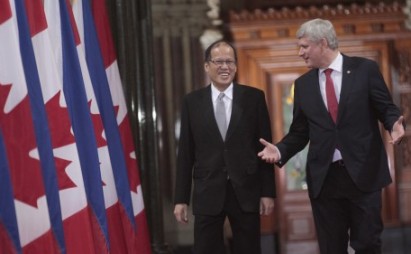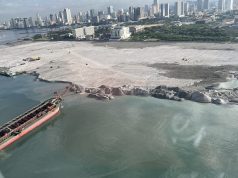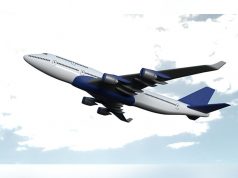
Editor’s note: Cesar Polvorosa Jr. is a business school professor of economics, world geography, and international business management in Canada. He is also a published writer in economics, business, and literature.
In Part 1, Cesar Polvorosa Jr. took off from the visit of President Aquino to Canada and described the relationship between Canada and the Philippines. Here, he tries to map the future of further relations between the two countries.
The Comparative Advantage Theory is the main basis for international trade. The theory is simply that countries specialize in the production of goods and services where they are good at (as measured by cost) compared to other countries while discounting the distortions of tariffs and trade barriers.
Canada as a huge country in the Northern Hemisphere is a high-tech industrial society in the trillion-dollar club of countries. Canada is similar to the US in its market-oriented economic system, pattern of production, and is a major supplier of energy, including oil, gas, uranium, and electric power given its abundant natural resources, highly skilled labor force, and modern capital plants. The country’s petroleum sector is rapidly expanding primarily because of the Alberta’s oil sands. (CIA World Factbook). The lower oil prices during the past year have of course adversely affected the Canadian economy.
With such a huge landmass and many fertile areas especially in the south, Canada is also a major agricultural producer. Main Canadian agricultural products include wheat, barley, oilseed, tobacco, fruits (such as apples), vegetables, dairy products, and fish and forest products.
A major strength of the Canadian economy likewise is that because of its natural resource endowments such as precious metals and its high human capital and proximity to the US market it has also evolved to become a major industrial economy as a producer of transportation equipment, chemicals, processed and unprocessed minerals, food products, wood and paper products, fish products, petroleum, and natural gas (CIA World Factbook).
Philippines: Rich in resources too
On the other hand, the Philippines is a tropical archipelago made up of 7,107 mostly verdant islands and has bountiful agricultural and mineral resources. The Philippines has been traditionally an agricultural country that is now transitioning toward industrialization and services.
The Philippines is a major producer of agricultural products that are associated with its location in the tropics: sugarcane, coconuts, rice, corn, bananas, cassava (manioc, tapioca), pineapples, mangoes; pork, eggs, beef; fish.
As noted, the country is also industrializing with electronics as its main exports. Its main industries include electronics assembly, garments, footwear, pharmaceuticals, chemicals, wood products, food processing, petroleum refining and fishing (CIA World Factbook).
There has been a lot of interest of foreign investors on the Philippine economy during the past few years such as shown in its record high $6.2 billion of FDIs in 2014. While Canada’s main focus to diversify its direction of trade from over dependence on the US has been toward China and India in the highly dynamic Asia-Pacific region the Philippines has now been catching attention.
Since 2010, the Philippine economy has grown at a robust annual average rate of 6.3 percent. The enviable growth record for 2010-2014 is actually the highest five-year average of the country for the past 40 years. The fundamentals of the economy remain stable.
Mutual attraction
The Philippines as a rapidly growing economy of 100 million therefore represents a potentially huge market especially at a time when there are few bright spots in the volatile and weak world economy.
Attractive Philippine industries include shipbuilding, processing and assembly operations in electronics manufacturing, aerospace industry and BPO for Canadian investments. Canadian equipment can help modernize the Philippine military as evidenced by a recent deal to acquire Canadian helicopters. The Philippines can also consider Canada in the diversification of its energy sources and transport equipment such as railway cars and locomotives.
At the same time, an advanced and prosperous country like Canada represents a big market for raw materials, processed and packaged food, tropical agricultural products, competitively priced industrial products, electronics from the Philippines as well as transnational business opportunities because of the growing Filipino immigrant community in Canada.
It is clear that there is a lot untapped potential in Philippine-Canada trade relationship considering the size, state, and prospects of the two economies and the differences in factor conditions that justify enhanced trade between two countries.
For instance, an economic peer of Canada such as Australia which has significantly lower population (though nearer to the Philippines) has much bigger trade with the Philippines amounting to $1.6 billion for the relevant period. It would be a noteworthy bilateral target for Canada to be among the top #10 trading partners of the Philippines in the near future.
Canada focus on PH
Some of the concrete results of the visit of President Aquino include: launching exploratory discussions toward a free trade agreement and upgrading the existing Foreign Investment Promotion and Protection Agreement, an offer of assistance through the Canadian Trade and Development Facility to enable Philippine SMEs to better access the Canadian Market, and the framing of a Mutual Accountability Framework to support broad based and sustainable economic growth in the Philippines.
The Philippines had been designated by Canada as a priority market under Canada’s Global Markets Action Plan (GMAP). Under the GMAP, Canada will focus on high potential markets for Canadian businesses. The GMAP will promote linkages to international business partners, international research, venture capital, and entrepreneurial services.
The Philippines is also a country of focus for the government of Canada’s international development efforts. The designation translates into a special focus on the Philippines. Subsequently, it is anticipated that development programming in the Philippines will increase.
There are also expanded air linkages between the Philippines and Canada. Canada has agreed to double the number of flights to the Philippines from the present seven agreed in May 2008 to 14 flights a week today.
Both Philippine and Canadian businesses have the capabilities and are well-positioned to take advantage of the business opportunities in both countries in the coming years in an enhanced mutually beneficial bilateral relationship.









